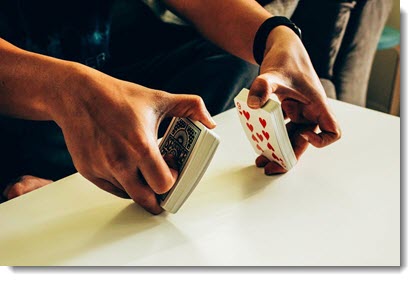Many people think poker looks far too complicated for them to learn to play, but the reality couldn’t be more different. The basics are incredibly easy to pick up, and with a little bit of practice you will be able to play a confident game. With online poker so readily available, both in free-to-play and real-money options, getting the practice in has never been easier. The advantages of playing poker online are that you can limit yourself to beginner rooms, you can keep a cheat sheet of tips by you while you’re playing, and you’re unlikely to come up against master strategists, meaning you can take the time to learn the rules without having to also think about analyzing bluffs.
There are many different variations of poker, the most popular of which are Texas Hold ‘Em, Omaha and 7 Card Stud. All have the same hand configurations, but the way you draw cards and make those hands is different in each game. We’re going to focus on Texas Hold ‘Em for this beginner’s guide, but Omaha follows the same rules very closely. Here’s a quick guide to the basics.
Hand Configurations
The point of the game is to make the best combination of cards. In Texas Hold ‘Em you have two cards which are kept a secret from your opponents – these are called your hole cards – and five communal cards which are face up in the center of the table and used by everybody. Using these seven cards, you need to make a better five-card poker hand than anyone else. Here are the poker hands in order from best to worst:
- Straight Flush –five consecutive cards of the same suit
- Four of a Kind – all four matching cards, one from each suit
- Full House – a pair and three of a kind e.g. KK 333
- Flush – five cards of the same suit
- Straight – five consecutive cards
- Three of a Kind – three matching cards
- Two Pair – two different matching pairs e.g. AA 99
- Pair – a matching pair of cards
- High Card – five different, unsuited cards, ranked by the highest value
Because you have seven cards to use to make the best hand, there’s a slightly better chance of you being able to find a good combination.
Top Tip: After seeing your hole cards, you’ll be asked to ante up or fold. If you don’t have a pair or at least one picture card, it’s best to fold.
Betting Structure
In a game of Texas Hold ‘Em, there are three important roles – big blind, small blind and the dealer. These rotate round the table every hand. The blinds make forced bets regardless of their cards, so that there is always something to win. Big blind makes the minimum bet and small blind is half that. Everyone else then gets a chance to fold (withdraw from the round), place a bet, raise the existing bet.
Top Tip: Be careful going in with an aggressive raise – it might scare everyone else into folding and then, if you so have the best cards, you’ll only win a small pot.
After everyone has bet or folded, the dealer reveals three communal cards in the center of the table. This is known as the Flop. Everyone gets another chance to bet, with the additional option to check – pass on betting – as long as no one has made a bet yet. Then a fourth card – the Turn – and a fifth card – the River – are drawn, with more rounds of betting after each. In total, there are four rounds of betting in Texas Hold ‘Em.
Evaluating the Cards
Building a good hand is not always enough to win you the game. The best poker players can accurately predict what cards their opponents are holding, using a combination of probability, logical deduction, and experience. Because there are five community cards, you can get a good idea of what the other players might be holding. For example, if three or four of the central cards are of the same suit, there’s a good chance someone might have a flush – be on the lookout for how everyone bets as each card is revealed, as it could give you an idea of whether or not that was a helpful card for them.
Bluffing
Knowing when and how to bluff can help you get one over on your opponents. A simple way to get started is by acting the opposite way to the cards that you have. If you’ve gone in on a pot and the flop hasn’t turned up anything useful for you, but its showing the potential for high pairs or a flush, then you might put everyone else off by betting as if you’ve struck gold. Alternatively, if you are pretty sure that your hand is a winner, you want to encourage the other players to keep betting to increase the pot size, and your winnings. So don’t bet like you’re holding the winning hand; limp into pots and pretend to agonize over calling other raises.
Poker is easy to learn, but can take a lifetime to master. Your best options are to choose a variation, familiarize yourself with the rules and the terms, and get plenty of practice.

